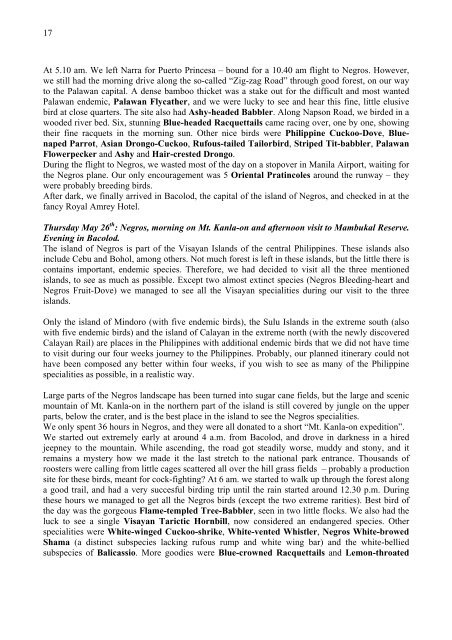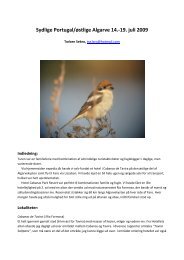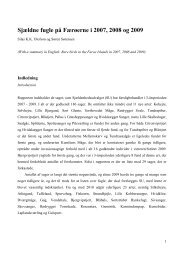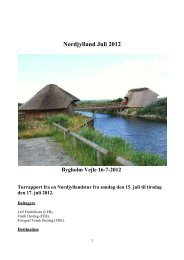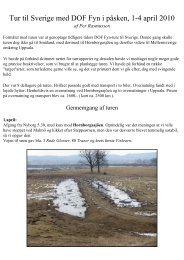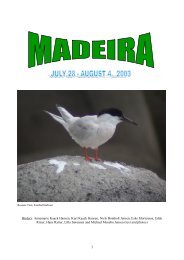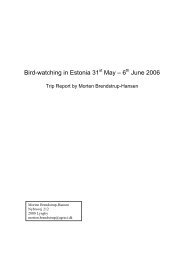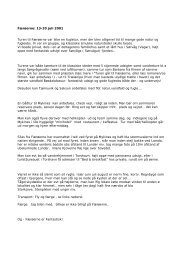Rockjumper Birding Tours - Netfugl.dk
Rockjumper Birding Tours - Netfugl.dk
Rockjumper Birding Tours - Netfugl.dk
Create successful ePaper yourself
Turn your PDF publications into a flip-book with our unique Google optimized e-Paper software.
17<br />
At 5.10 am. We left Narra for Puerto Princesa – bound for a 10.40 am flight to Negros. However,<br />
we still had the morning drive along the so-called “Zig-zag Road” through good forest, on our way<br />
to the Palawan capital. A dense bamboo thicket was a stake out for the difficult and most wanted<br />
Palawan endemic, Palawan Flycather, and we were lucky to see and hear this fine, little elusive<br />
bird at close quarters. The site also had Ashy-headed Babbler. Along Napson Road, we birded in a<br />
wooded river bed. Six, stunning Blue-headed Racquettails came racing over, one by one, showing<br />
their fine racquets in the morning sun. Other nice birds were Philippine Cuckoo-Dove, Bluenaped<br />
Parrot, Asian Drongo-Cuckoo, Rufous-tailed Tailorbird, Striped Tit-babbler, Palawan<br />
Flowerpecker and Ashy and Hair-crested Drongo.<br />
During the flight to Negros, we wasted most of the day on a stopover in Manila Airport, waiting for<br />
the Negros plane. Our only encouragement was 5 Oriental Pratincoles around the runway – they<br />
were probably breeding birds.<br />
After dark, we finally arrived in Bacolod, the capital of the island of Negros, and checked in at the<br />
fancy Royal Amrey Hotel.<br />
Thursday May 26 th : Negros, morning on Mt. Kanla-on and afternoon visit to Mambukal Reserve.<br />
Evening in Bacolod.<br />
The island of Negros is part of the Visayan Islands of the central Philippines. These islands also<br />
include Cebu and Bohol, among others. Not much forest is left in these islands, but the little there is<br />
contains important, endemic species. Therefore, we had decided to visit all the three mentioned<br />
islands, to see as much as possible. Except two almost extinct species (Negros Bleeding-heart and<br />
Negros Fruit-Dove) we managed to see all the Visayan specialities during our visit to the three<br />
islands.<br />
Only the island of Mindoro (with five endemic birds), the Sulu Islands in the extreme south (also<br />
with five endemic birds) and the island of Calayan in the extreme north (with the newly discovered<br />
Calayan Rail) are places in the Philippines with additional endemic birds that we did not have time<br />
to visit during our four weeks journey to the Philippines. Probably, our planned itinerary could not<br />
have been composed any better within four weeks, if you wish to see as many of the Philippine<br />
specialities as possible, in a realistic way.<br />
Large parts of the Negros landscape has been turned into sugar cane fields, but the large and scenic<br />
mountain of Mt. Kanla-on in the northern part of the island is still covered by jungle on the upper<br />
parts, below the crater, and is the best place in the island to see the Negros specialities.<br />
We only spent 36 hours in Negros, and they were all donated to a short “Mt. Kanla-on expedition”.<br />
We started out extremely early at around 4 a.m. from Bacolod, and drove in darkness in a hired<br />
jeepney to the mountain. While ascending, the road got steadily worse, muddy and stony, and it<br />
remains a mystery how we made it the last stretch to the national park entrance. Thousands of<br />
roosters were calling from little cages scattered all over the hill grass fields – probably a production<br />
site for these birds, meant for cock-fighting? At 6 am. we started to walk up through the forest along<br />
a good trail, and had a very succesful birding trip until the rain started around 12.30 p.m. During<br />
these hours we managed to get all the Negros birds (except the two extreme rarities). Best bird of<br />
the day was the gorgeous Flame-templed Tree-Babbler, seen in two little flocks. We also had the<br />
luck to see a single Visayan Tarictic Hornbill, now considered an endangered species. Other<br />
specialities were White-winged Cuckoo-shrike, White-vented Whistler, Negros White-browed<br />
Shama (a distinct subspecies lacking rufous rump and white wing bar) and the white-bellied<br />
subspecies of Balicassio. More goodies were Blue-crowned Racquettails and Lemon-throated


